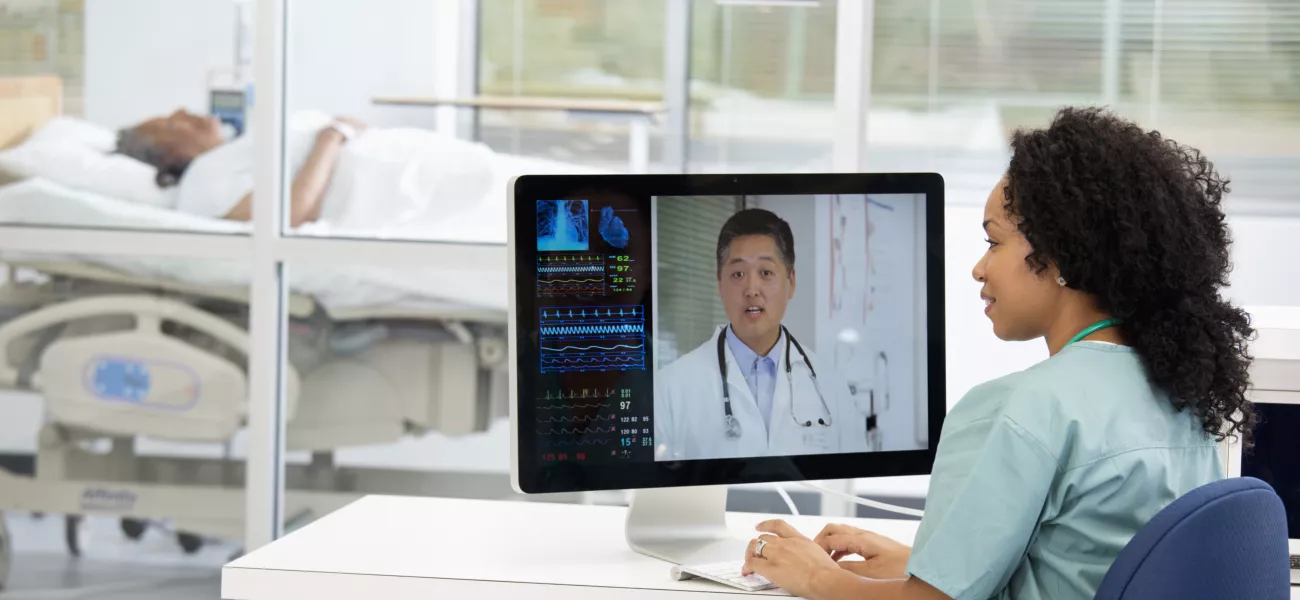
At Axis, we are at the forefront of providing innovative solutions to deliver quality patient care, as well as more proactive and efficient ways of working. This blog explores how virtual nursing will shape the future of healthcare.
Nurses are on the front lines of patient care. Often the first point of contact for patients, nurses maintain direct and ongoing contact throughout their hospital stay. It’s a crucial job.
But nursing is evolving. Delivering quality patient care now depends on developing more proactive and efficient ways of working, and getting smarter in how we approach this. Doing so helps ensure that healthcare providers are where they’re needed when it matters most. To enable this, hospitals are increasingly adopting digital technologies in their workflows, which is driving efficiency and faster access to skills across a broader cohort of patients. This has led to the increased adoption of ‘virtual nursing’.
Virtual nursing refers to the integration of video and audio solutions into wider telemetry systems to augment patient care delivery. It is already significantly changing the way hospitals operate. In fact, most hospitals in North America are expected to install virtual support systems over the next three to five years.
This blog explores how this technology is being used to enable nurses to provide care for general nursing across the patient and resident populations, with a focus on intensive care units, described as ‘tele-ICU’, as well as patient sitting, or ‘tele-sitting’.
The latest innovations in general nursing:
Bedside staff allocation represents a significant challenge for healthcare providers. One of the costliest expenses for hospitals, for instance, is to place a nurse in a room with a patient to monitor their health and execute tasks that can be virtualized.
This is where intelligent network solutions come in. Provided systems operate on an open architecture, which enables them to be integrated as part of a hospital’s existing software, this technology can help radically transform and accelerate workflows, while still delivering the highest standards of care. This prevents you from being ‘locked in’ to costly proprietary solutions.
The installation of in-room two-way video cameras makes it possible for nursing staff to continuously monitor and communicate with multiple patients from a central or decentralized location. Given that highly skilled nurses are often in high demand due to the level of their expertise, this remote solution enables them to provide high-quality care to multiple patients, irrespective of location.
Additionally, built-in audio capabilities can further enhance the patient experience. Preconfigured with high-quality sound and enabling two-way communication with high audio intelligibility, patients can see and speak directly with nurses, and vice versa.
This is particularly useful to help facilitate the following: clinical video conferencing and consultations, whereby nurses and clinicians share a care plan with the patient and discuss their treatment, dual medication validation for the administration of medicines, remote admissions and discharge, virtual rounding, and virtual visitations.
The value of virtual nursing in the ICU:
Intensive care is particularly crucial when integrating network solutions to deliver patient care. At-risk patients require near constant monitoring, with specially trained nursing staff responsible for checking vital signs and administering treatment.
With the use of network cameras, healthcare facilities can provide nurses with a stable feed with the sharp, detailed, true-to-life images needed for ICU care, which is referred to as ‘tele-ICU’. These solutions empower nurses to establish and maintain robust situational awareness across their entire patient panel, no matter where they are or what they’re doing.
As an example, Nemours Children’s Hospital in Orlando, Florida, has created a Tactical Logistics Center (TLC), where a rotating team continually checks patient vital signs through a central monitoring system. This integrates both clinical data and live streaming video in each patient’s room to ensure they receive 24/7 care, enabling nursing staff to provide essential consistent monitoring while not being physically present.
This can be integral for wards that require highly skilled, specialist nurses, enabling them to combine in-room and virtual nursing to improve patient outcomes.
Taking these practices to wider patient care:
Patient sitting is an indispensable part of ensuring safety and providing quality care. However, many healthcare providers struggle to secure enough personnel for this time and resource-intensive form of care.
As a complement to virtual nursing, tele-sitting can be used to monitor patients remotely to ensure they are not at risk. With the use of in-room network cameras, remote staff members, like patient safety technicians, can continuously monitor multiple patients from a central location. This helps to ensure adequate coverage, even with minimal staff present.
Adding intelligent video analytics helps you to detect fall-risk or flight-risk patients who have left their beds, while audio analytics on a speaker or audio-equipped cameras can provide a minimally intrusive way of identifying audible sounds such as distress, aggression, and excessive coughing. Meanwhile, convenient ad hoc two-way communication options make it easy for sitters to speak with patients as needed.
Furthermore, with a multi-tenant architecture, multiple departments can use the same system. This enables greater return on investment (ROI) as one system can offer multiple uses across a hospital, fostering greater collaboration and efficiencies.
Protecting patients:
Virtual nursing and remote patient monitoring doesn’t come without its challenges, particularly in relation to protecting patients.
Of course, it is important to match hardware to the patient population here. If a camera is placed in a room in a behavioral health area, precautions must be taken to enhance patient safety, so they do not use the equipment to harm themselves. It is also important to select the right hardware in relation to video quality. High-quality imagery is critical when it comes to ensuring patient safety, as healthcare practitioners can clearly see the patient and monitor for any observable signs of distress or changes to their state of health. By installing tailored cameras for the specific use case, you can improve patient care and outcomes – both within a hospital setting and in wider care facilities.
An integral part of virtual nursing is aligning with Health Insurance Portability and Accountability Act (HIPAA) compliant architecture, which ensures your hospital is adhering to healthcare data regulations. The National Defense Authorization Act (NDAA) and the Trade Agreements Act (TAA) requirements are also important considerations for all forms of healthcare related critical infrastructure.
Patient privacy can be safeguarded using edge-based analytics within cameras. These capabilities enable the dynamic masking of people’s faces and bodies in real-time, allowing the observer to see movements while safeguarding the patients’ identity.
Devices must also have cyber protection in place, to ensure that patient data is encrypted and protected.
A solution for the future:
Healthcare is continually evolving, with new, innovative solutions helping to shape the future of the sector. The use of virtual solutions will become an even more essential part of healthcare. It not only optimizes workflows through better-allocated resourcing but increases overall patient satisfaction levels. With more technological support available to monitor patients, nurses are can safeguard patients and improve the quality of care.
